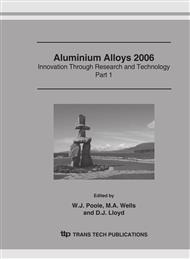p.1871
p.1877
p.1883
p.1889
p.1895
p.1901
p.1907
p.1913
p.1919
Effect of Heat Treatment Condition and Alloy Composition on Hydrogen Content in Al-Mg Alloys
Abstract:
The effect of heat treatment conditions such as atmosphere, temperature, annealing time and alloying elements on the hydrogen content in Al-Mg based alloys was investigated. The hydrogen content after annealing depends on the annealing atmospheres and alloying elements. When annealed in a wet atmosphere, the release of the hydrogen in the Al-Mg alloys to outside and the absorption of hydrogen from atmosphere into Al-Mg alloys are presumed to occur at the same time. The oxide layer on the surface is revealed to prevent the hydrogen from being released to outside. The spheroidal MgO particles can be seen on the surface of Al-Mg alloys after annealing at 550°C. The number of the MgO particles increases with increasing impurity elements such as Si and Fe, reducing the shielding effect against hydrogen permeration. Therefore, the condensation of hydrogen near the surface after annealing occurs more easily in an Al-Mg alloy of a high-purity than that of an ordinary purity.
Info:
Periodical:
Pages:
1895-1900
Citation:
Online since:
July 2006
Authors:
Keywords:
Price:
Сopyright:
© 2006 Trans Tech Publications Ltd. All Rights Reserved
Share:
Citation:


